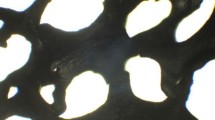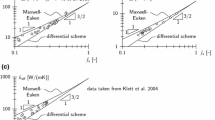Abstract
Cellular metal foams are of interest because of the ability to tailor their mechanical, thermal, acoustic, and electrical properties by varying the relative density and cell morphology. Here, a tetrakaidecahedral unit-cell approach is used to represent an open-cell aluminum foam and a simplified electrical resistor network derived to model low frequency current flow through the foam. The analysis indicates that for the range of relative densities studied (4–12%), the conductivity of tetrakaidecahedral foams has a linear dependence upon relative density. The distribution of metal in the cell ligaments was found to significantly affect the conductivity. Increasing the fraction of metal at the ends of the ligaments resulted in a decrease in electrical conductivity at a fixed relative density. Low frequency electrical conductivity measurements of an open-cell aluminum foam (ERG Duocel) confirmed the linear dependence upon density, but the slope was smaller than that predicted by the unit-cell model. The difference between the model and experiment was found to be the result of the presence of a distribution of cell sizes and types in real samples. This effect is due to the varying number of ligaments, ligament lengths, and the cross-sectional areas available for current conduction across the cellular structure.
Similar content being viewed by others
References
M.F. Ashby, A.G. Evans, N.A. Fleck, L.J. Gibson, J.W. Hutchinson, and H.N.G. Wadley, Metal Foams: A Design Guide (Butterworth-Heinemann, Boston, MA, 2000).
A.G. Evans, J.W. Hutchinson, and M.F. Ashby, Harvard University, Report MECH-323 (1998).
V. Shapovalov, MRS Bull. 19(4), 24 (1994).
G.J. Davies and S. Zhen, J. Mater. Sci. 18, 1899 (1983).
Mepura Data Sheet Metallpulvergesellschaft m.b.H., Randshofern, Austria (1995).
S. Langlois and F. Coeuret, J. Appl. Electrochem. 19, 43 (1989).
K.P. Dharmasena and H.N.G. Wadley, in Porous and Cellular Materials for Structural Applications, edited by D.S. Schwartz, D.S. Shih, A.G. Evans, and H.N.G. Wadley (Mater. Res. Soc. Symp. Proc. 521, Warrendale, PA, 1998), pp. 171–176.
Metals Handbook, Desk edition, edited by H.E. Boyer and T.L. Gall. (American Society for Metals, Metals Park, OH, 1985), pp. 6–32.
A.M. Kraynik, M.K. Neilsen, D.A. Reinelt, and W.E. Warren, in Foams and Emulsions, edited by J.F. Sadoc and N. Rivier (Kluwer, Boston, 1999) pp. 259–286.
Author information
Authors and Affiliations
Rights and permissions
About this article
Cite this article
Dharmasena, K.P., Wadley, H.N.G. Electrical Conductivity of Open-cell Metal Foams. Journal of Materials Research 17, 625–631 (2002). https://doi.org/10.1557/JMR.2002.0089
Received:
Accepted:
Published:
Issue Date:
DOI: https://doi.org/10.1557/JMR.2002.0089




